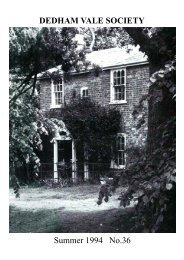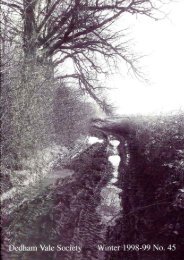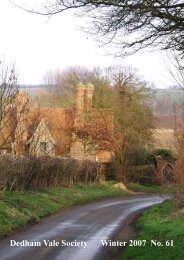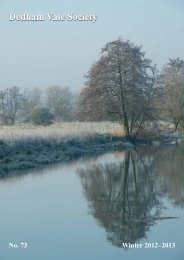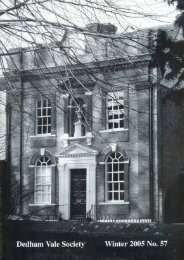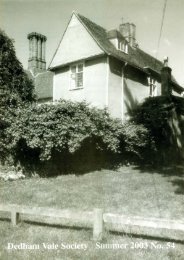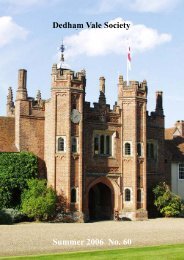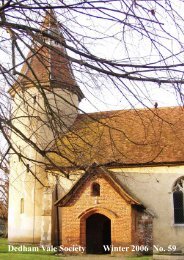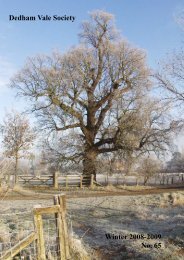Dedham Vale Society
68 - Summer 2010 pdf 1.5Mb - Dedham Vale Society
68 - Summer 2010 pdf 1.5Mb - Dedham Vale Society
- No tags were found...
Create successful ePaper yourself
Turn your PDF publications into a flip-book with our unique Google optimized e-Paper software.
THE CASE AGAINST THE PYLONSNational Grid(NG)’s original timetable was for the consultation on route corridor options to close at theend of February 2010, to be followed immediately by selection of a route corridor and consultationabout its’ detailed alignment. Consultation still continues, nominally about the choice of route corridor,but in practice about the stage prior to that, ie the choice between a new line of pylons from Bramford toTwinstead and the alternatives. NG attempted not to consult about this – the real issue – but have beenobliged to do so, thanks to the community groups including DVS which refused to engage on NG’sterms and debate the choice of route corridor. NG now envisage announcing the route corridor inSeptember, but accept that if consultation takes longer, that will be delayed.This became clear at a meeting on Monday 14 June organised by the Infrastructure Planning Commission(IPC), the body which the previous government created to decide major infrastructure applications suchas the Bramford – Twinstead pylons.There were four groups at the meeting:IPC, led by a Commissioner, Jan BessellNG, led by someone new to us, Hector Pearson, Stakeholder Group Manager from corporate HQ(ie not a technician or a consultant like those we had met before)Councils – Suffolk & Essex CCs, Babergh and Braintree DCsCampaign groups – the coalition opposing all route corridors (Colne-Stour CountrysideAssociation, Bury Not Blight, Stour Valley Underground and DVS) and the Groton PylonAlliance (which essentially is concerned only to oppose the northern corridors 3 & 4).The substantive part of the meeting opened by Charles Aldous, Chairman of the Colne-StourCountryside Association and a retired senior QC, making a statement on behalf of the coalition ofgroups opposing all route corridors. This attacked both legs of the NG case: the need for newtransmission capacity, and the choice between options for new transmission capacity.On need, NG’s original public case was that new generating capacity – two gas power stations, SizewellC and offshore wind farms – necessitated new pylons immediately. W e now know that:Sizewell C is delayed by at least four years and will not start generating until 2020 at earliest.Wind farms do not add to the need for on-shore transmission capacity, because they are an alternativeto fossil fuel capacity. If the wind blows, that much less gas power is needed, and viceversa.Upgrading the existing pylons will provide more than enough capacity for the two new gaspower stations.NG now tell us that their need case is not a matter of capacity, but of security of transmission. This is ahighly technical matter, and one which emerged as central to their case only as the original consultationclosed. We have had minimal opportunity to probe this issue, but already it appears that there areoptions to deal with security of supply issues other than by a second line of pylons Bramford –Twinstead. The simplest is simply to turn down the new gas power stations, should there be an incidentthreatening security of transmission. NG were clearly on the back foot on this at the meeting.8



